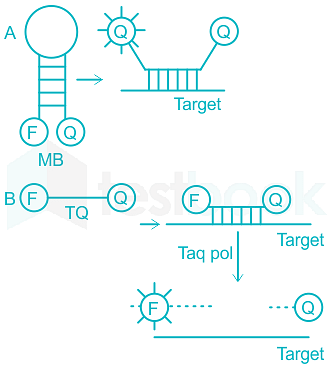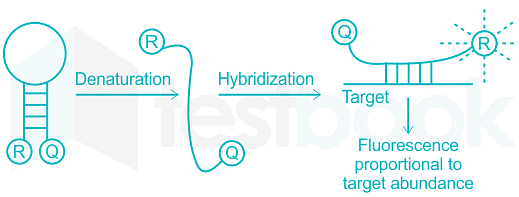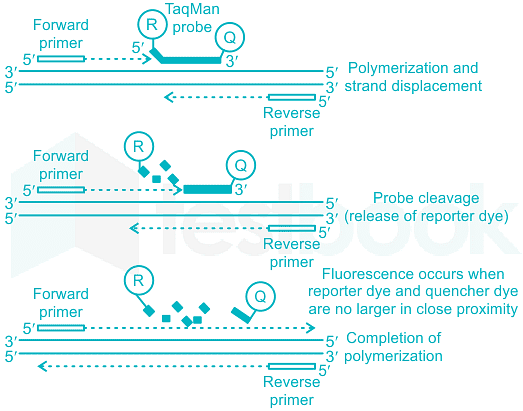Software Development Exam > Software Development Questions > Real-time PCR methods involve TaqMan (TQ) and...
Start Learning for Free
Real-time PCR methods involve TaqMan (TQ) and molecular beacons (MB) as probes. Both of these probes use a fluorophore (F) and a quencher and are based on the FRET concept (Q). However, as the following example shows, their various ways of operation

At what stage of the PCR we would be able to detect fluorescence?
- a)Annealing step for both.
- b)Extension step for both.
- c)Annealing for A and Extension for B.
- d)Extension for A and Annealing for B.
Correct answer is option 'C'. Can you explain this answer?
Verified Answer
Real-time PCR methods involve TaqMan (TQ) and molecular beacons (MB) a...
Concept:
- Real-time PCR or quantitative PCR (QPCR) is a powerful technique that allows measurement of PCR product while the amplification reaction proceeds.
- It incorporates the fluorescent element into conventional PCR as the calculation standard to provide a quantitative result. In this sense, fluorescent chemistry is the key component in QPCR.
- Till now, two types of fluorescent chemistries have been adopted in the QPCR systems: one is nonspecific probe and the other is specific.
- As a brilliant invention by Kramer et al. in 1996, molecular beacon is naturally suited as the reporting element in real-time PCR and has been adapted for many molecular biology applications whereas TaqMan PCR uses a nucleic-acid probe complementary to an internal segment of the target DNA.
Explanation:
- A Molecular beacon is a single-stranded bi-labeled fluorescent probe held in a hairpin-loop conformation (around 20 to 25 nt) by complementary stem sequences (around 4 to 6 nt) at both ends of the probe.
- The 5’ and 3’ ends of the probe contain a reporter and a quencher molecule, respectively.
- The loop is a single-stranded DNA sequence complementary to the target sequence. The proximity of the reporter and quencher causes the quenching of the natural fluorescence emission of the reporter.
- Molecular beacons hybridize to their specific target sequence causing the hairpin-loop structure to open and separate the 5’ end reporter from the 3’ end quencher.
- As the quencher is no longer in proximity to the reporter, fluorescence emission takes place.
- The measured fluorescence signal is directly proportional to the amount of target DNA.
Fig 1.Molecular Beacons Work
TaqMan PCR is a type of real-time PCR.
- TaqMan PCR uses a nucleic-acid probe complementary to an internal segment of the target DNA.
- The probe is labeled with two fluorescent moieties.
- The emission spectrum of one overlaps the excitation spectrum of the other, resulting in “quenching” of the first fluorophore by the second.
- The probe is present during the PCR and if product is made, the probe is degraded via the 5′-nuclease activity of Taq polymerase that is specific for DNA hybridized to template (=TaqMan activity).
- The degradation of the probe allows the two fluorophores to separate, which reduces quenching and increases intensity of the emitted light.
- Because this assay involves fluorescence measurements that can be performed without opening the PCR tube, the risk of contamination is greatly reduced.
Fig 2:
TaqMan PCR

hence the correct answer is option 3

|
Explore Courses for Software Development exam
|

|
Similar Software Development Doubts
Real-time PCR methods involve TaqMan (TQ) and molecular beacons (MB) as probes. Both of these probes use a fluorophore (F) and a quencher and are based on the FRET concept (Q). However, as the following example shows, their various ways of operation At what stage of the PCR we would be able to detect fluorescence?a)Annealing step for both.b)Extension step for both.c)Annealing for A and Extension for B.d)Extension for A and Annealing for B.Correct answer is option 'C'. Can you explain this answer?
Question Description
Real-time PCR methods involve TaqMan (TQ) and molecular beacons (MB) as probes. Both of these probes use a fluorophore (F) and a quencher and are based on the FRET concept (Q). However, as the following example shows, their various ways of operation At what stage of the PCR we would be able to detect fluorescence?a)Annealing step for both.b)Extension step for both.c)Annealing for A and Extension for B.d)Extension for A and Annealing for B.Correct answer is option 'C'. Can you explain this answer? for Software Development 2025 is part of Software Development preparation. The Question and answers have been prepared according to the Software Development exam syllabus. Information about Real-time PCR methods involve TaqMan (TQ) and molecular beacons (MB) as probes. Both of these probes use a fluorophore (F) and a quencher and are based on the FRET concept (Q). However, as the following example shows, their various ways of operation At what stage of the PCR we would be able to detect fluorescence?a)Annealing step for both.b)Extension step for both.c)Annealing for A and Extension for B.d)Extension for A and Annealing for B.Correct answer is option 'C'. Can you explain this answer? covers all topics & solutions for Software Development 2025 Exam. Find important definitions, questions, meanings, examples, exercises and tests below for Real-time PCR methods involve TaqMan (TQ) and molecular beacons (MB) as probes. Both of these probes use a fluorophore (F) and a quencher and are based on the FRET concept (Q). However, as the following example shows, their various ways of operation At what stage of the PCR we would be able to detect fluorescence?a)Annealing step for both.b)Extension step for both.c)Annealing for A and Extension for B.d)Extension for A and Annealing for B.Correct answer is option 'C'. Can you explain this answer?.
Real-time PCR methods involve TaqMan (TQ) and molecular beacons (MB) as probes. Both of these probes use a fluorophore (F) and a quencher and are based on the FRET concept (Q). However, as the following example shows, their various ways of operation At what stage of the PCR we would be able to detect fluorescence?a)Annealing step for both.b)Extension step for both.c)Annealing for A and Extension for B.d)Extension for A and Annealing for B.Correct answer is option 'C'. Can you explain this answer? for Software Development 2025 is part of Software Development preparation. The Question and answers have been prepared according to the Software Development exam syllabus. Information about Real-time PCR methods involve TaqMan (TQ) and molecular beacons (MB) as probes. Both of these probes use a fluorophore (F) and a quencher and are based on the FRET concept (Q). However, as the following example shows, their various ways of operation At what stage of the PCR we would be able to detect fluorescence?a)Annealing step for both.b)Extension step for both.c)Annealing for A and Extension for B.d)Extension for A and Annealing for B.Correct answer is option 'C'. Can you explain this answer? covers all topics & solutions for Software Development 2025 Exam. Find important definitions, questions, meanings, examples, exercises and tests below for Real-time PCR methods involve TaqMan (TQ) and molecular beacons (MB) as probes. Both of these probes use a fluorophore (F) and a quencher and are based on the FRET concept (Q). However, as the following example shows, their various ways of operation At what stage of the PCR we would be able to detect fluorescence?a)Annealing step for both.b)Extension step for both.c)Annealing for A and Extension for B.d)Extension for A and Annealing for B.Correct answer is option 'C'. Can you explain this answer?.
Solutions for Real-time PCR methods involve TaqMan (TQ) and molecular beacons (MB) as probes. Both of these probes use a fluorophore (F) and a quencher and are based on the FRET concept (Q). However, as the following example shows, their various ways of operation At what stage of the PCR we would be able to detect fluorescence?a)Annealing step for both.b)Extension step for both.c)Annealing for A and Extension for B.d)Extension for A and Annealing for B.Correct answer is option 'C'. Can you explain this answer? in English & in Hindi are available as part of our courses for Software Development.
Download more important topics, notes, lectures and mock test series for Software Development Exam by signing up for free.
Here you can find the meaning of Real-time PCR methods involve TaqMan (TQ) and molecular beacons (MB) as probes. Both of these probes use a fluorophore (F) and a quencher and are based on the FRET concept (Q). However, as the following example shows, their various ways of operation At what stage of the PCR we would be able to detect fluorescence?a)Annealing step for both.b)Extension step for both.c)Annealing for A and Extension for B.d)Extension for A and Annealing for B.Correct answer is option 'C'. Can you explain this answer? defined & explained in the simplest way possible. Besides giving the explanation of
Real-time PCR methods involve TaqMan (TQ) and molecular beacons (MB) as probes. Both of these probes use a fluorophore (F) and a quencher and are based on the FRET concept (Q). However, as the following example shows, their various ways of operation At what stage of the PCR we would be able to detect fluorescence?a)Annealing step for both.b)Extension step for both.c)Annealing for A and Extension for B.d)Extension for A and Annealing for B.Correct answer is option 'C'. Can you explain this answer?, a detailed solution for Real-time PCR methods involve TaqMan (TQ) and molecular beacons (MB) as probes. Both of these probes use a fluorophore (F) and a quencher and are based on the FRET concept (Q). However, as the following example shows, their various ways of operation At what stage of the PCR we would be able to detect fluorescence?a)Annealing step for both.b)Extension step for both.c)Annealing for A and Extension for B.d)Extension for A and Annealing for B.Correct answer is option 'C'. Can you explain this answer? has been provided alongside types of Real-time PCR methods involve TaqMan (TQ) and molecular beacons (MB) as probes. Both of these probes use a fluorophore (F) and a quencher and are based on the FRET concept (Q). However, as the following example shows, their various ways of operation At what stage of the PCR we would be able to detect fluorescence?a)Annealing step for both.b)Extension step for both.c)Annealing for A and Extension for B.d)Extension for A and Annealing for B.Correct answer is option 'C'. Can you explain this answer? theory, EduRev gives you an
ample number of questions to practice Real-time PCR methods involve TaqMan (TQ) and molecular beacons (MB) as probes. Both of these probes use a fluorophore (F) and a quencher and are based on the FRET concept (Q). However, as the following example shows, their various ways of operation At what stage of the PCR we would be able to detect fluorescence?a)Annealing step for both.b)Extension step for both.c)Annealing for A and Extension for B.d)Extension for A and Annealing for B.Correct answer is option 'C'. Can you explain this answer? tests, examples and also practice Software Development tests.

|
Explore Courses for Software Development exam
|

|
Signup for Free!
Signup to see your scores go up within 7 days! Learn & Practice with 1000+ FREE Notes, Videos & Tests.
























